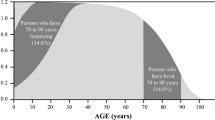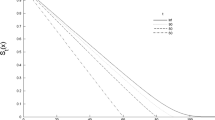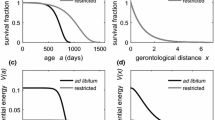Abstract
Carey’s Equality pertaining to stationary models is well known. In this paper, we have stated and proved a fundamental theorem related to the formation of this Equality. This theorem will provide an in-depth understanding of the role of each captive subject, and their corresponding follow-up duration in a stationary population. We have demonstrated a numerical example of a captive cohort and the survival pattern of medfly populations. These results can be adopted to understand age-structure and aging process in stationary and non-stationary population models.


Similar content being viewed by others
References
Brookmeyer R, Gail MH (1988) A method for obtaining short-term projections and lower bounds on the size of the AIDS epidemic. J Am Stat Assoc 83(402):301–308
Carey JR, Papadopoulos N, Müller H-G, Katsoyannos B, Kouloussis N, Wang J-L, Wachter K, Yu W, Liedo P (2008) Age structure changes and extraordinary life span in wild medfly populations. Aging Cell 7:426–437
Carey JR, Müller H-G, Wang J-L, Papadopoulos NT, Diamantidis A, Kouloussis NA (2012) Graphical and demographic synopsis of the captive cohort method for estimating population age structure in the wild. Exp Gerontol 47:787–791
Cox DR (1962) Renewal theory. Methuen and Co, London
Feller W (1941) On the integral equation of renewal theory. Ann Math Stat 12(3):243–267
Feller W (1971) An introduction to the probability theory and its applications, vol II, 2nd edn. Wiley, New York
Goldstein JR (2009) Life lived equals life left in stationary populations. Demogr Res 20:3–6
Goswami A, Rao BV (2006) A course in applied stochastic processes. Hindustan Book Agency (India), New Delhi
Karlin S (1969) A first course in stochastic process. Academic Press Inc, New York
Kim YJ, Aron JL (1989) On the equality of average age and average expectation of remaining life in a stationary population. SIAM Rev 31(1):110–113. doi:10.1137/1031005
Lawler GF (2006) Introduction to stochastic process (2/e). Chapman & Hall, London
Lotka AJ (1907) Relation between birth rates and death rates. Science 26:21–22
Lotka AJ (1939a) A contribution to the theory of self-renewing aggregates with special reference to industrial replacement. Ann Math Stat 10:1–25
Lotka AJ (1939b) On an integral equation in population analysis. Ann Math Stat 10:144–161
Lotka AJ (1956) Elements of mathematical biology. Dover Publications, New York Inc
Müller HG, Wang J-L, Carey JR, Caswell-Chen EP, Chen C, Papadopoulos N, Yao F (2004) Demographic window to aging in the wild: constructing life tables and estimating survival functions from marked individuals of unknown age. Aging Cell 3:125–131
Preston SH, Heuveline P, Guillot M (2001) Demography: measuring and modeling population processes. Blackwell Publishers, Malden
Ryder NB (1975) Notes on stationary populations. Popul Index 41(1):3–28
Rao ASRS, Carey JR (2014) Behavior of Carey’s Equality in two-dimensions: age and proportion of population (manuscript in-preparation)
Rao ASRS (2015) Incubation periods under various anti-retroviral therapies in homogeneous mixing and age-structured dynamical models: a theoretical approach. Rocky Mountain J Math (to appear in 2015). http://projecteuclid.org/DPubS?verb=Display&version=1.0&service=UI&handle=euclid.rmjm/1379596735&page=record
Rao ASRS (2014) Population stability and momentum. Not Am Math Soc 61(9):1162–1165
Vaupel JW (2009) Life lived and left: Carey’s Equality. Demogr Res 20(2009):7–10
Acknowledgments
We thank the organizers of the Keyfitz Centennial Symposium on Mathematical Demography sponsored by the Mathematical Biosciences Institute, Ohio State University, June 2013. Research by JRC supported by NIA/NIH Grants P01 AG022500-01 and P01 AG08761-10.
Author information
Authors and Affiliations
Corresponding author
Rights and permissions
About this article
Cite this article
Srinivasa Rao, A.S.R., Carey, J.R. Generalization of Carey’s equality and a theorem on stationary population. J. Math. Biol. 71, 583–594 (2015). https://doi.org/10.1007/s00285-014-0831-6
Received:
Revised:
Published:
Issue Date:
DOI: https://doi.org/10.1007/s00285-014-0831-6




